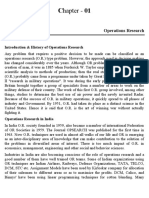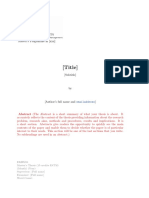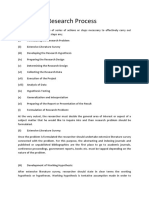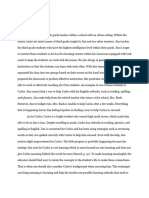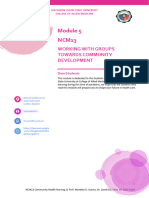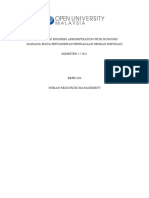Name:
Roll No:
1
�Contents
1. Introduction..............................................................................................................................2
2. Technology’s Role in Enhancing Learning Outcomes.............................................................3
2.1. Engagement and Active Learning.....................................................................................3
2.2. Retention and Cognitive Skills Development...................................................................3
2.3. ICT in Classrooms: Transformative Potential..................................................................3
2.4. Challenges in measuring Impact.......................................................................................4
2.5. Inequitable Access to Technology....................................................................................4
3. Challenges of Technology Integration.....................................................................................4
3.1. Teacher Training and Readiness.......................................................................................4
3.2. Excessive Reliance on Technology...................................................................................5
3.3. Potential for Distractions..................................................................................................5
4. Pedagogical Strategies for Technology Integration.................................................................5
4.1. Blended Learning Models.................................................................................................5
4.2. Project-Based Learning with Technology.........................................................................6
4.3. Fostering Critical Thinking and Creativity Through Technology....................................6
4.4. Collaborative Learning with Technology.........................................................................7
4.5. The Role of Educational Leadership in Technology Integration......................................7
5. Conclusion................................................................................................................................8
6. Future Research Directions......................................................................................................8
7. Reference list............................................................................................................................9
2
� 1. Introduction
To Nelson Mandela, "Education is the most powerful weapon you can use to change the world".
In this statement, education is deemed greatly essential for the society as a key to future
development. Technological advancements are one of the most vibrant opportunities that the
education sector has been accorded in the 21st century. Communication technology has
advanced from being an add-on resource to being a part of the learning process. In simple terms,
with the use of multimedia in classroom requirements, Advanced Information and
Communication Technologies (ICT) are restructuring teaching-learning methodologies all over
the world (Bhat, 2023).
The purpose of this review is to evaluate the effectiveness of technology integration in Teaching
and Learning with special emphasis on engagement, retention, and cognitive abilities and the
associated difficulties. Based on the analysis of the available literature sources, this review
synthesizes the data obtained from academic sources, policy reports, and case studies on the
given topic. Some of the words used in the study like ICT and technology integration will be
explained in detail. However, the review will also consider the global views on the use of
technology in education, a theoretical framework for practicing and implementing such
technological advances, and most importantly the importance of integrating the past approaches
to education and the present technological approaches. On a positive note, technological
advancement has several advantages however its drawbacks include; the technological divide,
technological dependency, insufficient preparation, and professional development of educational
teachers (Koh, Chai, and Lim, 2016).
Therefore, this review aims to fill any existing gaps in the literature and provide suggestions to
educators and policymakers that will be of help in implementing information technology in
classrooms.
2. Technology’s Role in Enhancing Learning Outcomes
Technology applications have impacted the learning, learning-teaching process, and even the
academic performance of the students. The authors substantiate their discoveries by noting that,
when employed efficiently, technology increases interest, improves understanding, and builds
3
�essential thought processes (Schaerer, Schweinsberg, and Swaab, 2018). This section looks at
how several instruments have enhanced learning outcomes, especially through the incorporation
of ICT and multimedia in teaching and learning.
2.1. Engagement and Active Learning
This paper seeks to highlight the kind of technology that can be used to boost the involvement of
learners. Instructors and learners use applications, games, role-play, and other types of online
technology to enhance the learning environment into a highly engaging environment. For
instance, Kahoot, Quizizz, etc., provide real-time reactions through the form of quizzes making
for an environment where students get more involved (Chauhan, 2017).
Furthermore, websites such as YouTube and Khan Academy also allow students to study at their
own pace making what could be hard to grasp easy. In general, depending on the implementation
of the flipped classroom model, which implies the study of materials outside of the classroom
and discussion in the classroom, multimedia facilities are actively used (Vongkulluksn, Xie, and
Bowman, 2018).
2.2. Retention and Cognitive Skills Development
Technology also helps in increasing retention rates. Tangible and audio-visual teaching methods
facilitate students' understanding of intended knowledge effectively as they combine the
understanding of knowledge through different stimuli such as sight and hearing. For example,
students who employ interactive digital resources memorize more information in comparison
with the students who study using traditional printed text. It also advances specific thought
processes, problem-solving, teamwork, and analysis. Google Classroom and Microsoft Teams
are the platforms that help students' cooperation and collaboration, while simulation and AR
apps, such as Labster, provide context-based activities for practice using theoretical knowledge
(Ghavifekr and Rosdy, 2015).
2.3. ICT in Classrooms: Transformative Potential
ICT solutions have been put into practice more effectively in developing nations in particular.
Such methods as India Digital and SWAYAM have ensured that students in rural areas get hub
to the tools of digital learning. Modern electronics in developed countries include the ICT
personalized learning technologies, for instance, the AI learning applications (Mong, 2015). It
4
�remodels the content to be delivered according to the student's performance so that all students
receive the necessary support and struggle.
2.4. Challenges in measuring Impact
While there are endless benefits of adopting technology in education, several issues need to be
solved to make the best use of technology in education. Of these challenges, the primary ones
include barriers to access, teachers' training, and the social impacts of over-reliance on
technology (Lin, Chen, and Liu, 2017). These are discussed in this section together with the
ensuing effects on the efficient integration of technology in teaching.
2.5. Inequitable Access to Technology
The major issue in use of technology in education is a problem as to how to address the issue of;
Lack of equitable access to technology and the World Wide Web. A social problem that cuts
across the world and creates a problem that students in rural or disadvantaged areas are mostly
affected. The UDISE report (2021) reveals that while internet facilities in schools in India have
improved from 18.7% in 2018 to 34% in 2022, a large number of students deny the use of the
essential technology (Utsav Kumar Singh, 2024). It is not only the case in developing countries
that experience it in an intense manner. Technological inequality also exists across the developed
and developed nation with the urban schools possessing more technologies than the rural schools
and the private institutions owning more technologies than the public institutions.
Students who do not have reliable connection to the internet urged up to date digital devices are
often failed to engage in technological activities in education. This problem intensified due to the
COVID-19 pandemic that animated millions of students to online learning without proper
equipment. Discriminations of this nature enhance the reinforcement of achievement gaps
especially within the disadvantaged communities and therefore, parity to technology must be
given maximum priority by the regional policy makers.
3. Challenges of Technology Integration
Some of the emerging problems include the digital divide in terms of the utilization of digital
instrumentation and the Internet. This issue is commonly known as the digital divide, it affects
students in rural or disadvantaged areas most especially. Some sorts of inequalities also exist
even in the developed countries, there are significant differences even in obtaining necessary
5
�resources for the schools situated in urban areas, and the schools located in rural areas or low-
income areas. The problem has been greatly worsened by the COVID-19 pandemic which saw
most learners shift to online learning, yet they lacked the appropriate technology. Inequalities
cause existing achievement divides to expand, with negative impacts on minorities; a rationale
for policymakers to have equal utilization of the technology.
3.1. Teacher Training and Readiness
Another important factor is the poor preparation of teachers in technology integration into the
course and classroom teaching. Issues of incorporation and integration of rapidly advancing
technologies are a concern that most teachers experience and traditional teacher preparation
programs do not prepare or adequately prepare teachers to handle technology-enhanced teaching
environments. This study showed that teachers require constant coaching and training to
integrate the use of technology in their classrooms. If the above is not done, even the high-tech
models will not be effectively deployed as envisaged in enhancing student learning (A.W.
(Tony) Bates, 2015).
3.2. Excessive Reliance on Technology
Using technology is good in many ways, but relying on technology has its drawbacks in lessons
that were not thought of by the technology developers. These are the effects of excessive screen
time on students' learning and development; scholarly and social (Wilson, Ritzhaupt, and Cheng,
2020). It is claimed that children who spend too much time in front of screens may have such
problems as less attention, and more aggressive manners. Thirdly, technology tends to reduce
interpersonal communication to an extreme degree necessary in a classroom to foster social and
emotional growth. That means teachers have to strike a balance between using technology where
it is best utilized to support learning and employing traditional methods where they work better
at doing so.
3.3. Potential for Distractions
Technological intervention's possibility to divert the student's and professors' attention is another
issue. Students are Dubai particularly use electronic devices for purposes other than learning
activities mostly during a lesson they are engaged in social plings, gaming, and other unrelated
activities like texting. Scholars also show that students who take part in these activities during
class are most probably to be low achievers. To prevent these distractions, teachers need to set
6
�rules to model appropriate use of technology and explain to students how to deal with
distractions and how to be responsible users of technology.
To overcome this, teachers must set measures on the usage of technology in teaching and
learning. Introducing various lessons that concern the use of digital technology can enable
teachers and learners alike to develop coping mechanisms as well as enable the learners to
develop proper use of the technologies. The teacher should set clear rules and guidelines when it
comes to the use of the devices so that technology can remain a valuable asset rather than being
the cause of distractions.
4. Pedagogical Strategies for Technology Integration
In essence, it remains clear that while there are existing problems in technology integration, the
proper instructional practices will assist in eradicating these problems, rather than allowing the
tools to complicate the learning process. This section discusses ways that technology can be
incorporated into classroom practices, the place of mixed learning approaches, and ways to
promote critical and creative thinking by use of technology.
4.1. Blended Learning Models
Among the various methods of implementing the use of technology in learning, the system
referred to as blended learning may be considered one of the most successful. In the opinion of
Ceylan and Kesici, 2017, blended learning is a program under which students can obtain benefits
from both face-to-face and conventional classroom study models and, on the same note,
complete to and fro computerized teaching lessons with face-to-face interaction added to it. I
believe this model enables students to proceed with their learning at their own pace while still
being able to get all the help they need from the teacher. Blended Learning has been in practice
in the recent past because of its versatility when it comes to tutoring. For instance, a student can
watch tapes or make comments on discussion boards at home that can allow ascending
engagements in class. Also, the type of models used in blended learning makes it possible for the
teacher to address the diverse achievement levels in the classroom. For example, educators can
recommend materials that will address learners' preferences or give extra help to learners who
struggle with class content.
7
�However, effective practice of blended learning calls for advanced planning and organization. In
other words, the teachers have to choreograph the student–facilitator and the technology-
mediated interactions in ways that add up to the intended learning outcomes. Moreover,
technology has to remain a tool in the teachers' hands as a method that supports and develops
their pedagogical approach. For example, engaging in computer visualizations in science classes
can enrich activities that involve youth experiments to bring richer meanings to learners.
4.2. Project-Based Learning with Technology
Another of the instructional models that can be supported and reinforced by the use of
technologies is Project-Based Learning (PBL). PBL makes learners solve real-life issues, in
some cases in groups, and develop solutions out of their learning. As postulated by Afriana,
Permanasari, and Fitriani, 2016, this is because PBL enhances a deep approach by having
students assume the role of learners together with other benefits such as the ability to foster
critical and analytical skills as well as problem-solving and communication skills. In PBL,
technology is used to assist the students in finding information, using learning tools, and
accessing forums, amongst other things. For instance, through electronic information retrieval,
students may conduct research activities by using information technology tools, work in groups
in computer-based work, and present information in an electronic style. Instead of being a means
of delivery, technology becomes a way to support creativity and team approaches in the
framework of PBL. Bell stated by Al-Abdullatif and Gameil, 2021, observed that, when students
use technology in PBL contexts, they master skills that can be applied to other real-life contexts
such as working in teams across distance, using analysis tools, and generating digital
deliverables.
To ensure that PBL is appropriately used with technology, the teachers need to be certain that the
technology tools adopted fall in place appropriately to serve the learning goals. The teachers
should also give the learners the time to self-assess, peer assess, and have a chance to make
corrections to their work. Such strontium helps in promoting a critical thinking perspective and
helps the students to enhance their ideas continually.
4.3. Fostering Critical Thinking and Creativity Through Technology
Technologies can also be used to foster analysis, synthesis, and evaluation skills, which form the
basis of what is entailing critical thinking skills. For example, asynchronous computer
8
�conferences, computer-simulated phenomena, and interactive electronic books affect thinking in
reflection, involving cooperation and sharing of different views on phenomena. The use of
technology to enrich content knowledge by introducing novelty in meaning-making processes
tends to enhance long-term knowledge retention, as reported by Varier et al., 2017.
Another area that can greatly benefit from technology is creativity. Applications such as graphic
interface, video edition, and digital storytelling, can be used by students showing their creativity
and ideas into a technology tool. If teachers integrate creative productions into the program, they
guide students in mastering one major hand tool daily, while at the same enhancing the
children’s creativity which is vital in the current job market. Kokotsaki, Menzies, and Wiggins,
(2016), research also revealed that when students create with technology, students are more
highly invested and interested in the learning process and more likely to continue learning
throughout their lives. In any case, teachers must give students the direction they should take so
that they can apply soft and hard technologies in problem-solving and innovation. Teachers
should demonstrate how solving problems should be done, support innovation and give
constructive criticism on students' work. Technology can and must be integrated to serve
learning objectives and it has to make students not merely passive recipients of relevant material.
4.4. Collaborative Learning with Technology
Another key actionable idea to integrate technology is that teamwork has to be promoted. Real-
time media which includes cooperative document editors, online dialogue boards, and video
conferencing systems help students to share, work on projects as well as give feedback in
realtime despite their location. As pointed by out Al-kalbi, (2016), comprehensive
communication, team building, and conflict-solving skills are a few important facets of
collaborative learning. To some extent, technology promotes collaboration as a vehicle for
enhancing communication and sharing of resources either in the classroom or through online
learning systems.
But, effective learning with the use of advanced technology is not an easy task, it has to be well
coordinated. Teachers need to ensure that students know what to do as learners in teams, how to
use technology appropriately, and how to embrace other people's opinions. In general, the
described approach implies creating conditions that will promote cooperation, and by equipping
9
�the students with tools and setting up the classroom environment, the educators can inspire the
students to give their best.
4.5. The Role of Educational Leadership in Technology Integration
Lastly, effective use of technology for Districts, Schools, and classrooms is closely related to
leadership across all levels of education. Teachers who are expected to integrate technology into
classroom practice and learning need to be under the support of educational leaders such as
school leaders and policymakers. As recommended by the National Educational Technology
Plan in 2017, leaders need to continue supporting teachers in professional development,
procurement of quality technology support, and support of cultures of inventiveness and teaming
(Bakhshaei et al., 2018). They also have to promote the adoption and incorporation of,
technology in the design of the curriculum and the accomplishment of better rates by the
students.
Also, educational leaders should involve technology professionals to enhance the appropriate
integration of technology into learning goals. According to educational leaders, embracing a
vision of technology as it supports teaching and learning, can assist in changing the culture of the
use of technology to support educational practices and thus support students.
5. Conclusion
Consequently, education is one of the fields that can be greatly impacted by the integration of
technology into the teaching-learning processes for students and teachers as well as augmenting
student and teacher interactivity. Nonetheless, it is argued that, to implement a successful one,
some elements include the following:
In this literature review, the effective approaches which include, but are not limited to, integrated
use of technology like blended learning, project-based learning, and collaborative learning have
also been discussed since they are other ways of promoting deeper learning. The successful
incorporation of technology in learning allows students to own their learning process, fosters
cooperation and pitches the learners into creative thinking. Furthermore, it is naive to an extent
to deny that technology can be applied effectively as an aid to enhance reflective thinking and
create differentiated classrooms.
10
�In addition to the foregoing, leadership support for educational technology appears to be a
critical factor. Educational leaders at all levels must ensure that teachers have the training and
resources needed to make effective use of technology in learning and teaching processes.
Another pressure on educational leaders is to promote a culture of innovation and technology
accessibility by all students as well.
As this paper has argued, technology offers numerous ways of improving learning despite the
need for a proper approach to its implementation. There are challenges that educators should
consider: the problem of technology overload, the problem of how to ensure students from
disadvantaged backgrounds are not left further behind, and the problem of constant professional
learning. For technology to be effective in education it requires the proactive cooperation of
educators, leaders, as well as policymakers in fashioning an open, progressive environment for
learning.
6. Future Research Directions
Subsequent studies in this area should therefore specifically consider trying to establish the
effects of integrating technology as a tool of delivery on learners’ performance as well as the
skills developed for the longer term (Tondeur et al., 2016). Furthermore, research that examined
the potential of concrete technological tools in different educational settings would be helpful for
teachers who endeavored to enhance their practice using technology. Moreover, the
investigations addressing the specific difficulties of teachers in the use of technologies, as well as
the effective practices that can help to overcome those issues, would also help to enhance the
understanding of the dynamics of technology usage in teaching.
This means that educational stakeholders should continue to invest in these directions in order to
always bring the technology integration idea as a force that can revolutionize the learning
processes and prepare the learners for the world of the future.
11
� 7. Reference list
A.W. (Tony) Bates (2015). Teaching in a Digital Age. [online] Opentextbc.ca. Available at:
https://opentextbc.ca/teachinginadigitalage/.
Afriana, J., Permanasari, A. and Fitriani, A. (2016). PROJECT-BASED LEARNING
INTEGRATED TO ENHANCE ELEMENTARY SCHOOL'S STUDENTS' SCIENTIFIC
LITERACY. Jurnal Pendidikan IPA Indonesia, [online] 5(2), pp.261–267.
doi:https://doi.org/10.15294/jpii.v5i2.5493.
Al-Abdullatif, A.M. and Gameil, A.A. (2021). The Effect of Digital Technology Integration on
Students’ Academic Performance through Project-Based Learning in an E-learning Environment.
International Journal of Emerging Technologies in Learning (iJET), 16(11), p.189.
doi:https://doi.org/10.3991/ijet.v16i11.19421.
Al-kaabi, A.F. (2016). Effects of collaborative learning on the achievement of students with
different learning styles at Qatar University. [online] bura.brunel.ac.uk. Available at:
https://bura.brunel.ac.uk/handle/2438/15137.
Bakhshaei, M., Hardy, A., Francisco, A., Noakes, S. and Fusco, J. (2018). Fostering Powerful
Use of Technology Through Instructional Coaching. [online] Dspacedirect.org. Available at:
https://digitalpromise.dspacedirect.org/handle/20.500.12265/48 [Accessed 28 Dec. 2024].
Bhat, R. (2023). THE IMPACT OF TECHNOLOGY INTEGRATION ON STUDENT LEARNING
OUTCOMES: A COMPARATIVE STUDY. [online] International Journal of Social Science.
Available at:
https://pdfs.semanticscholar.org/4036/43b81f84ba462e64f61be9227495eb2d352b.pdf.
Ceylan, V.K. and Kesici, A.E. (2017). Effect of blended learning to academic achievement.
Journal of Human Sciences, [online] 14(1), pp.308–320. Available at: https://www.j-
humansciences.com/ojs/index.php/IJHS/article/view/4141.
12
�Chauhan, S. (2017). A meta-analysis of the impact of technology on learning effectiveness of
elementary students. Computers & Education, 105(1), pp.14–30.
doi:https://doi.org/10.1016/j.compedu.2016.11.005.
Ghavifekr, S. and Rosdy, W.A.W. (2015). Teaching and Learning with Technology:
Effectiveness of ICT Integration in Schools. International Journal of Research in Education and
Science, [online] 1(2), pp.175–191. Available at: https://eric.ed.gov/?id=EJ1105224.
Koh, J.H.L., Chai, C.S. and Lim, W.Y. (2016). Teacher Professional Development for TPACK-
21CL. Journal of Educational Computing Research, 55(2), pp.172–196.
doi:https://doi.org/10.1177/0735633116656848.
Kokotsaki, D., Menzies, V. and Wiggins, A. (2016). Project-based learning: A review of the
literature. Improving Schools, [online] 19(3), pp.267–277.
doi:https://doi.org/10.1177/1365480216659733.
Lin, M.-H., Chen, H.-C. and Liu, K.-S. (2017). A Study of the Effects of Digital Learning on
Learning Motivation and Learning Outcome. EURASIA Journal of Mathematics, Science and
Technology Education, [online] 13(7), pp.3553–3564.
doi:https://doi.org/10.12973/eurasia.2017.00744a.
Mong, D. (2015). The teacher technology integration experience: Practice and reflection in the
classroom. Journal of Information Technology Education: Research, [online] 14, pp.161–178.
Available at: https://jite.org/documents/Vol14/JITEv14ResearchP161-178Ruggiero0958.pdf.
Schaerer, M., Schweinsberg, M. and Swaab, R.I. (2018). Imaginary alternatives: The effects of
mental simulation on powerless negotiators. Journal of Personality and Social Psychology,
115(1), pp.96–117. doi:https://doi.org/10.1037/pspi0000129.
Tondeur, J., Pareja Roblin, N., van Braak, J., Voogt, J. and Prestridge, S. (2016). Preparing
beginning teachers for technology integration in education: ready for take-off? Technology,
Pedagogy and Education, 26(2), pp.157–177.
doi:https://doi.org/10.1080/1475939x.2016.1193556.
13
�Varier, D., Dumke, E.K., Abrams, L.M., Conklin, S.B., Barnes, J.S. and Hoover, N.R. (2017).
Potential of one-to-one technologies in the classroom: teachers and students weigh in.
Educational Technology Research and Development, [online] 65(4), pp.967–992.
doi:https://doi.org/10.1007/s11423-017-9509-2.
Vongkulluksn, V.W., Xie, K. and Bowman, M.A. (2018). The role of value on teachers’
internalization of external barriers and externalization of personal beliefs for classroom
technology integration. Computers & Education, [online] 118, pp.70–81.
doi:https://doi.org/10.1016/j.compedu.2017.11.009.
Wilson, M.L., Ritzhaupt, A.D. and Cheng, L. (2020). The impact of teacher education courses
for technology integration on pre-service teacher knowledge: A meta-analysis study. Computers
& Education, 156, p.103941. doi:https://doi.org/10.1016/j.compedu.2020.103941.
Utsav Kumar Singh (2024). Implementation of Sustainable Development Goals in India:
Progress and Challenges. Advances in geographical and environmental sciences, pp.39–91.
doi:https://doi.org/10.1007/978-981-97-5846-3_2.
14































































